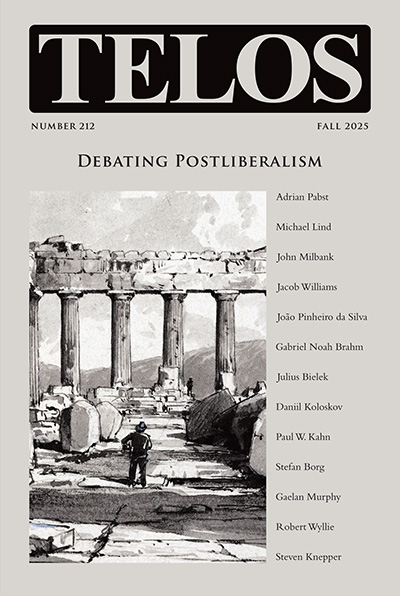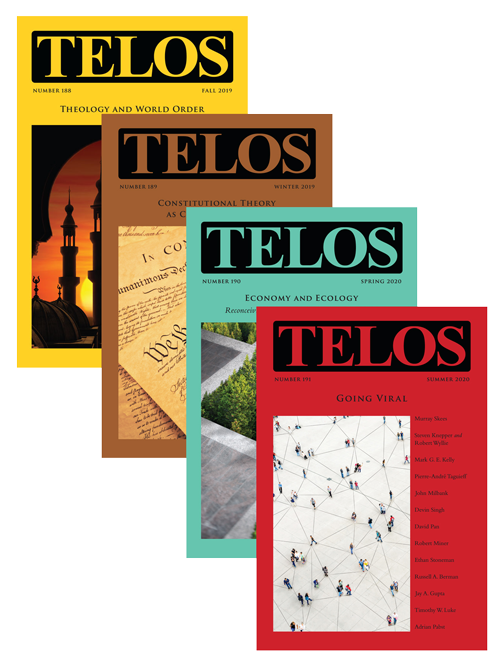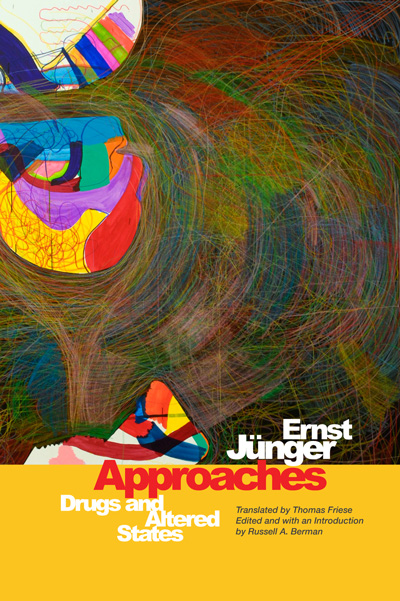By Damien Booth · Tuesday, October 16, 2012 As an occasional feature on TELOSscope, we highlight a past Telos article whose critical insights continue to illuminate our thinking and challenge our assumptions. Today, Damien Booth looks at Ronald Aronson’s “Interpreting Husserl and Heidegger: The Root of Sartre’s Thought” from Telos 13 (Fall 1972).
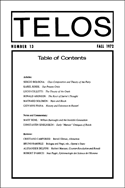 Readers familiar with Jean-Paul Sartre’s philosophical writings understand that he inherited a great deal of his conceptual language from the phenomenological projects of Edmund Husserl and Martin Heidegger. In “Interpreting Husserl and Heidegger: The Root of Sartre’s Thought,” Ronald Aronson strips away much of the mystery from Sartre’s concepts and, in so doing, reveals something about the framework that Sartre inherits that may well restrict his philosophical project from the very start. The accusation Aronson levies against Sartre is that he opens up a gap between consciousness and the world, a gap that Husserl wished to close by developing his transcendental phenomenological method. Essentially, Aronson thinks that Sartre abandons the very developments that made Husserl’s and Heidegger’s projects tenable in the first place: “we find [Sartre] erasing all the structures of consciousness (emotional, cognitive, and social) which make the world intelligible and making consciousness into a ‘nothing'” (47). As a result, Sartre becomes tangled up in his “own conceptual apparatus.” To find out why he gets so conceptually confused by these entanglements, Aronson traces Sartre’s key concepts back to their roots in Husserl’s cognitive projects and Heidegger’s hermeneutic phenomenology. Readers familiar with Jean-Paul Sartre’s philosophical writings understand that he inherited a great deal of his conceptual language from the phenomenological projects of Edmund Husserl and Martin Heidegger. In “Interpreting Husserl and Heidegger: The Root of Sartre’s Thought,” Ronald Aronson strips away much of the mystery from Sartre’s concepts and, in so doing, reveals something about the framework that Sartre inherits that may well restrict his philosophical project from the very start. The accusation Aronson levies against Sartre is that he opens up a gap between consciousness and the world, a gap that Husserl wished to close by developing his transcendental phenomenological method. Essentially, Aronson thinks that Sartre abandons the very developments that made Husserl’s and Heidegger’s projects tenable in the first place: “we find [Sartre] erasing all the structures of consciousness (emotional, cognitive, and social) which make the world intelligible and making consciousness into a ‘nothing'” (47). As a result, Sartre becomes tangled up in his “own conceptual apparatus.” To find out why he gets so conceptually confused by these entanglements, Aronson traces Sartre’s key concepts back to their roots in Husserl’s cognitive projects and Heidegger’s hermeneutic phenomenology.
Continue reading →
By James Hellings · Monday, October 15, 2012 James Hellings’s “Messages in a Bottle and Other Things Lost to the Sea: The Other Side of Critical Theory or a Reevaluation of Adorno’s Aesthetic Theory” appears in Telos 160 (Fall 2012). Read the full version online at the Telos Online website, or purchase a print copy of the issue here.
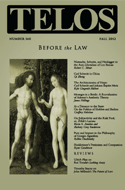 Drawing on a range of modern and contemporary works of art and literature (Edgar Allan Poe, Caspar David Friedrich, Bas Jan Ader, Tacita Dean), this essay seeks to exaggerate the aesthetic side of Adorno’s critical theory, re-evaluating the latter through a detailed analysis of the image of messages in a bottle. In overturning and displacing the critical genealogy of this image and in anchoring it to the construction of Adorno’s aesthetic and the work of art, I challenge the so-called “prevalent view” that transforms Adorno’s image into a pejorative logo for his alleged withdrawal into political quietism, pessimism, and resignation: a “strategy of hibernation.” Neither the critical theorists nor the activist critics of the Frankfurt School, I argue, have exclusivity over the image of messages in a bottle. If art is “the surviving message of despair from the shipwrecked,” then the work of art in Adorno’s aesthetics best expresses the paradox of engagement through disengagement, which itself translates Adorno’s standpoint on social praxis. Art turns socio-political, as with Friedrich’s Rückenfiguren, by turning away. Adorno valued radical new art for its distancing effect, for its great refusal, for becoming society’s Other. Art works well when complex antagonistic fragments crystallize into a force field, confronting, critiquing, and transforming the damaged life of society. Art, like the bottle of messages, is a container for truth and hope addressed to imaginary witnesses of an uncertain future, sent in spite of the aggressive indifference of the world, and aesthetics becomes, here at least, the privileged other of critical theory. Drawing on a range of modern and contemporary works of art and literature (Edgar Allan Poe, Caspar David Friedrich, Bas Jan Ader, Tacita Dean), this essay seeks to exaggerate the aesthetic side of Adorno’s critical theory, re-evaluating the latter through a detailed analysis of the image of messages in a bottle. In overturning and displacing the critical genealogy of this image and in anchoring it to the construction of Adorno’s aesthetic and the work of art, I challenge the so-called “prevalent view” that transforms Adorno’s image into a pejorative logo for his alleged withdrawal into political quietism, pessimism, and resignation: a “strategy of hibernation.” Neither the critical theorists nor the activist critics of the Frankfurt School, I argue, have exclusivity over the image of messages in a bottle. If art is “the surviving message of despair from the shipwrecked,” then the work of art in Adorno’s aesthetics best expresses the paradox of engagement through disengagement, which itself translates Adorno’s standpoint on social praxis. Art turns socio-political, as with Friedrich’s Rückenfiguren, by turning away. Adorno valued radical new art for its distancing effect, for its great refusal, for becoming society’s Other. Art works well when complex antagonistic fragments crystallize into a force field, confronting, critiquing, and transforming the damaged life of society. Art, like the bottle of messages, is a container for truth and hope addressed to imaginary witnesses of an uncertain future, sent in spite of the aggressive indifference of the world, and aesthetics becomes, here at least, the privileged other of critical theory.
Continue reading →
By Göran Dahl · Friday, October 12, 2012 Jens-Martin Eriksen and Frederik Stjernfelt’s The Democratic Contradictions of Multiculturalism, reviewed in this essay, is available for purchase here.
I cannot refrain from first saying that this is a must read-book. That goes for those who are critical of “multiculturalism”—whatever this means—and for those wanting to defend it.
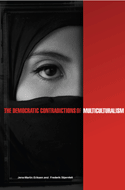 Let us begin the central concept in this book—multiculturalism. I have, when confronted with the word, been wondering if the one who utters it is referring to an ideological ideal or a state of affairs. The authors use a similar distinction: multiculturalism is confusing since it is often not clear what is meant. It can be either an existing condition or a coming condition. This kind of use is descriptive. Then we have the normative one: a necessary way to think and act in a society when we have different (most often) ethnically based communities with different ideas on what is right or wrong. Just remember the Danish Mohamed cartoons from some years ago, and now recently the short film ridiculing “the prophet” available on YouTube. All of this has led to a discussion of whether there should be limits on free speech that involves ironies, jokes, pictures, etc., that could make religious believers feel insulted. The objection of many others, including me, is that in a modern, western liberal democracy one can say or illustrate any religious matter in whatever way you want. The public sphere is totally secular, or at least it should be so.[1] If you feel insulted, this is a private reaction, outside the public sphere. The bottom line would then be very simple: the public sphere gives anyone the right to argue his or her opinion, while civil society is the sphere of emotions. As long as these emotions remain just emotions, there is no problem. But the reason why this is an important book is that we have seen the emergence of leaders in the west who have considered limitations regarding free speech so that no minority gets insulted. If we follow this logic to its conclusion, then cartoons illustrating stereotypes of men, for example, should also illegal. A related problem is self-censorship, which many modern writers and artists have admitted suffering from. So the problem starts to get very complicated. Let us begin the central concept in this book—multiculturalism. I have, when confronted with the word, been wondering if the one who utters it is referring to an ideological ideal or a state of affairs. The authors use a similar distinction: multiculturalism is confusing since it is often not clear what is meant. It can be either an existing condition or a coming condition. This kind of use is descriptive. Then we have the normative one: a necessary way to think and act in a society when we have different (most often) ethnically based communities with different ideas on what is right or wrong. Just remember the Danish Mohamed cartoons from some years ago, and now recently the short film ridiculing “the prophet” available on YouTube. All of this has led to a discussion of whether there should be limits on free speech that involves ironies, jokes, pictures, etc., that could make religious believers feel insulted. The objection of many others, including me, is that in a modern, western liberal democracy one can say or illustrate any religious matter in whatever way you want. The public sphere is totally secular, or at least it should be so.[1] If you feel insulted, this is a private reaction, outside the public sphere. The bottom line would then be very simple: the public sphere gives anyone the right to argue his or her opinion, while civil society is the sphere of emotions. As long as these emotions remain just emotions, there is no problem. But the reason why this is an important book is that we have seen the emergence of leaders in the west who have considered limitations regarding free speech so that no minority gets insulted. If we follow this logic to its conclusion, then cartoons illustrating stereotypes of men, for example, should also illegal. A related problem is self-censorship, which many modern writers and artists have admitted suffering from. So the problem starts to get very complicated.
Continue reading →
By Robbie Duschinsky · Thursday, October 11, 2012 Robbie Duschinsky’s “Pure and Impure in the Philosophy of Giorgio Agamben” appears in Telos 160 (Fall 2012). Read the full version online at the Telos Online website, or purchase a print copy of the issue here.
 The issue of the “ambiguity of the sacred” plays a significant role in Giorgio Agamben’s thought. Both the importance of the pure and impure to Agamben, and the nature of his theory of this issue, are revealed more clearly in his recent text Il Sacramento del Linguaggio. In contrast to functionalist explanations of themes of purity and impurity as an expression and affirmation of the social order (e.g., Emile Durkheim, Mary Douglas), Agamben considers purity and impurity as essentializing discourses. They contribute to the establishment of a transcendent but empty ideal, as the mandate for the social and political governance of individuals. In the course of this analysis, Agamben offers many philosophical reflections on purity and impurity that will be of note to researchers across the social sciences and humanities. The issue of the “ambiguity of the sacred” plays a significant role in Giorgio Agamben’s thought. Both the importance of the pure and impure to Agamben, and the nature of his theory of this issue, are revealed more clearly in his recent text Il Sacramento del Linguaggio. In contrast to functionalist explanations of themes of purity and impurity as an expression and affirmation of the social order (e.g., Emile Durkheim, Mary Douglas), Agamben considers purity and impurity as essentializing discourses. They contribute to the establishment of a transcendent but empty ideal, as the mandate for the social and political governance of individuals. In the course of this analysis, Agamben offers many philosophical reflections on purity and impurity that will be of note to researchers across the social sciences and humanities.
Continue reading →
By Katherine McGinity · Tuesday, October 9, 2012 As an occasional feature on TELOSscope, we highlight a past Telos article whose critical insights continue to illuminate our thinking and challenge our assumptions. Today, Katherine McGinity looks at Dimitri Ginev’s “The Erotic Attitude Toward Nature and Cognitive Existentialism” from Telos 152 (Fall 2010).
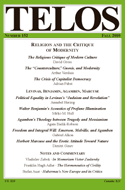 Dimitri Ginev’s “The Erotic Attitude Toward Nature and Cognitive Existentialism” seeks to uncover ways in which Herbert Marcuse’s call for a “new science” could be achieved in current scientific research. Marcuse’s ideas are committed to an “erotic” attitude toward nature that moves away from the technological rationality that drives scientific research. Marcuse posits that engaging in an erotic attitude toward nature would allow natural entities to “be what they are” and reveal their inherent aesthetic qualities. According to Marcuse, this dramatic shift in scientific research would change essentialist thinking about science and its norms of objectivity. Ginev shares Marcuse’s feeling that current scientific research methods are problematic in their reductive approach to nature as something that can be controlled and manipulated. However, Ginev points out that attempting to dismantle the subjective-objective structure of modern science proves difficult based solely in Marcuse’s outline. Dimitri Ginev’s “The Erotic Attitude Toward Nature and Cognitive Existentialism” seeks to uncover ways in which Herbert Marcuse’s call for a “new science” could be achieved in current scientific research. Marcuse’s ideas are committed to an “erotic” attitude toward nature that moves away from the technological rationality that drives scientific research. Marcuse posits that engaging in an erotic attitude toward nature would allow natural entities to “be what they are” and reveal their inherent aesthetic qualities. According to Marcuse, this dramatic shift in scientific research would change essentialist thinking about science and its norms of objectivity. Ginev shares Marcuse’s feeling that current scientific research methods are problematic in their reductive approach to nature as something that can be controlled and manipulated. However, Ginev points out that attempting to dismantle the subjective-objective structure of modern science proves difficult based solely in Marcuse’s outline.
Continue reading →
By Brendan O'Connor · Friday, October 5, 2012
-
Two essays on pop culture: Kevin Craft explores the development of its representations of the liberal arts for The Atlantic, and Andrew O’Hehir explores its relationship to the American Right for Salon. In some ways, these two articles seem to describe conflicting trends. Is this the case, or is there a connection?
-
Also at The Atlantic, Conor Friedersdorf, with assistance from Orwell, unpacks medical metaphors in the military.
-
Hugo Koning reviews Emma Stafford’s Herakles, the latest installment in the Routledge series Gods and Heroes of the Ancient World, for the Bryn Mawr Classical Review: “Just as on the divine plane ‘everything begins with Zeus,’ so on the human plane almost all heroes of different generations, tales and locations are somehow connected to Herakles.”
Continue reading →
|
|
 Readers familiar with Jean-Paul Sartre’s philosophical writings understand that he inherited a great deal of his conceptual language from the phenomenological projects of Edmund Husserl and Martin Heidegger. In “Interpreting Husserl and Heidegger: The Root of Sartre’s Thought,” Ronald Aronson strips away much of the mystery from Sartre’s concepts and, in so doing, reveals something about the framework that Sartre inherits that may well restrict his philosophical project from the very start. The accusation Aronson levies against Sartre is that he opens up a gap between consciousness and the world, a gap that Husserl wished to close by developing his transcendental phenomenological method. Essentially, Aronson thinks that Sartre abandons the very developments that made Husserl’s and Heidegger’s projects tenable in the first place: “we find [Sartre] erasing all the structures of consciousness (emotional, cognitive, and social) which make the world intelligible and making consciousness into a ‘nothing'” (47). As a result, Sartre becomes tangled up in his “own conceptual apparatus.” To find out why he gets so conceptually confused by these entanglements, Aronson traces Sartre’s key concepts back to their roots in Husserl’s cognitive projects and Heidegger’s hermeneutic phenomenology.
Readers familiar with Jean-Paul Sartre’s philosophical writings understand that he inherited a great deal of his conceptual language from the phenomenological projects of Edmund Husserl and Martin Heidegger. In “Interpreting Husserl and Heidegger: The Root of Sartre’s Thought,” Ronald Aronson strips away much of the mystery from Sartre’s concepts and, in so doing, reveals something about the framework that Sartre inherits that may well restrict his philosophical project from the very start. The accusation Aronson levies against Sartre is that he opens up a gap between consciousness and the world, a gap that Husserl wished to close by developing his transcendental phenomenological method. Essentially, Aronson thinks that Sartre abandons the very developments that made Husserl’s and Heidegger’s projects tenable in the first place: “we find [Sartre] erasing all the structures of consciousness (emotional, cognitive, and social) which make the world intelligible and making consciousness into a ‘nothing'” (47). As a result, Sartre becomes tangled up in his “own conceptual apparatus.” To find out why he gets so conceptually confused by these entanglements, Aronson traces Sartre’s key concepts back to their roots in Husserl’s cognitive projects and Heidegger’s hermeneutic phenomenology.  Drawing on a range of modern and contemporary works of art and literature (Edgar Allan Poe, Caspar David Friedrich, Bas Jan Ader, Tacita Dean), this essay seeks to exaggerate the aesthetic side of Adorno’s critical theory, re-evaluating the latter through a detailed analysis of the image of messages in a bottle. In overturning and displacing the critical genealogy of this image and in anchoring it to the construction of Adorno’s aesthetic and the work of art, I challenge the so-called “prevalent view” that transforms Adorno’s image into a pejorative logo for his alleged withdrawal into political quietism, pessimism, and resignation: a “strategy of hibernation.” Neither the critical theorists nor the activist critics of the Frankfurt School, I argue, have exclusivity over the image of messages in a bottle. If art is “the surviving message of despair from the shipwrecked,” then the work of art in Adorno’s aesthetics best expresses the paradox of engagement through disengagement, which itself translates Adorno’s standpoint on social praxis. Art turns socio-political, as with Friedrich’s Rückenfiguren, by turning away. Adorno valued radical new art for its distancing effect, for its great refusal, for becoming society’s Other. Art works well when complex antagonistic fragments crystallize into a force field, confronting, critiquing, and transforming the damaged life of society. Art, like the bottle of messages, is a container for truth and hope addressed to imaginary witnesses of an uncertain future, sent in spite of the aggressive indifference of the world, and aesthetics becomes, here at least, the privileged other of critical theory.
Drawing on a range of modern and contemporary works of art and literature (Edgar Allan Poe, Caspar David Friedrich, Bas Jan Ader, Tacita Dean), this essay seeks to exaggerate the aesthetic side of Adorno’s critical theory, re-evaluating the latter through a detailed analysis of the image of messages in a bottle. In overturning and displacing the critical genealogy of this image and in anchoring it to the construction of Adorno’s aesthetic and the work of art, I challenge the so-called “prevalent view” that transforms Adorno’s image into a pejorative logo for his alleged withdrawal into political quietism, pessimism, and resignation: a “strategy of hibernation.” Neither the critical theorists nor the activist critics of the Frankfurt School, I argue, have exclusivity over the image of messages in a bottle. If art is “the surviving message of despair from the shipwrecked,” then the work of art in Adorno’s aesthetics best expresses the paradox of engagement through disengagement, which itself translates Adorno’s standpoint on social praxis. Art turns socio-political, as with Friedrich’s Rückenfiguren, by turning away. Adorno valued radical new art for its distancing effect, for its great refusal, for becoming society’s Other. Art works well when complex antagonistic fragments crystallize into a force field, confronting, critiquing, and transforming the damaged life of society. Art, like the bottle of messages, is a container for truth and hope addressed to imaginary witnesses of an uncertain future, sent in spite of the aggressive indifference of the world, and aesthetics becomes, here at least, the privileged other of critical theory.  Let us begin the central concept in this book—multiculturalism. I have, when confronted with the word, been wondering if the one who utters it is referring to an ideological ideal or a state of affairs. The authors use a similar distinction: multiculturalism is confusing since it is often not clear what is meant. It can be either an existing condition or a coming condition. This kind of use is descriptive. Then we have the normative one: a necessary way to think and act in a society when we have different (most often) ethnically based communities with different ideas on what is right or wrong. Just remember the Danish Mohamed cartoons from some years ago, and now recently the short film ridiculing “the prophet” available on YouTube. All of this has led to a discussion of whether there should be limits on free speech that involves ironies, jokes, pictures, etc., that could make religious believers feel insulted. The objection of many others, including me, is that in a modern, western liberal democracy one can say or illustrate any religious matter in whatever way you want. The public sphere is totally secular, or at least it should be so.[1] If you feel insulted, this is a private reaction, outside the public sphere. The bottom line would then be very simple: the public sphere gives anyone the right to argue his or her opinion, while civil society is the sphere of emotions. As long as these emotions remain just emotions, there is no problem. But the reason why this is an important book is that we have seen the emergence of leaders in the west who have considered limitations regarding free speech so that no minority gets insulted. If we follow this logic to its conclusion, then cartoons illustrating stereotypes of men, for example, should also illegal. A related problem is self-censorship, which many modern writers and artists have admitted suffering from. So the problem starts to get very complicated.
Let us begin the central concept in this book—multiculturalism. I have, when confronted with the word, been wondering if the one who utters it is referring to an ideological ideal or a state of affairs. The authors use a similar distinction: multiculturalism is confusing since it is often not clear what is meant. It can be either an existing condition or a coming condition. This kind of use is descriptive. Then we have the normative one: a necessary way to think and act in a society when we have different (most often) ethnically based communities with different ideas on what is right or wrong. Just remember the Danish Mohamed cartoons from some years ago, and now recently the short film ridiculing “the prophet” available on YouTube. All of this has led to a discussion of whether there should be limits on free speech that involves ironies, jokes, pictures, etc., that could make religious believers feel insulted. The objection of many others, including me, is that in a modern, western liberal democracy one can say or illustrate any religious matter in whatever way you want. The public sphere is totally secular, or at least it should be so.[1] If you feel insulted, this is a private reaction, outside the public sphere. The bottom line would then be very simple: the public sphere gives anyone the right to argue his or her opinion, while civil society is the sphere of emotions. As long as these emotions remain just emotions, there is no problem. But the reason why this is an important book is that we have seen the emergence of leaders in the west who have considered limitations regarding free speech so that no minority gets insulted. If we follow this logic to its conclusion, then cartoons illustrating stereotypes of men, for example, should also illegal. A related problem is self-censorship, which many modern writers and artists have admitted suffering from. So the problem starts to get very complicated.  Dimitri Ginev’s “The Erotic Attitude Toward Nature and Cognitive Existentialism” seeks to uncover ways in which Herbert Marcuse’s call for a “new science” could be achieved in current scientific research. Marcuse’s ideas are committed to an “erotic” attitude toward nature that moves away from the technological rationality that drives scientific research. Marcuse posits that engaging in an erotic attitude toward nature would allow natural entities to “be what they are” and reveal their inherent aesthetic qualities. According to Marcuse, this dramatic shift in scientific research would change essentialist thinking about science and its norms of objectivity. Ginev shares Marcuse’s feeling that current scientific research methods are problematic in their reductive approach to nature as something that can be controlled and manipulated. However, Ginev points out that attempting to dismantle the subjective-objective structure of modern science proves difficult based solely in Marcuse’s outline.
Dimitri Ginev’s “The Erotic Attitude Toward Nature and Cognitive Existentialism” seeks to uncover ways in which Herbert Marcuse’s call for a “new science” could be achieved in current scientific research. Marcuse’s ideas are committed to an “erotic” attitude toward nature that moves away from the technological rationality that drives scientific research. Marcuse posits that engaging in an erotic attitude toward nature would allow natural entities to “be what they are” and reveal their inherent aesthetic qualities. According to Marcuse, this dramatic shift in scientific research would change essentialist thinking about science and its norms of objectivity. Ginev shares Marcuse’s feeling that current scientific research methods are problematic in their reductive approach to nature as something that can be controlled and manipulated. However, Ginev points out that attempting to dismantle the subjective-objective structure of modern science proves difficult based solely in Marcuse’s outline. 